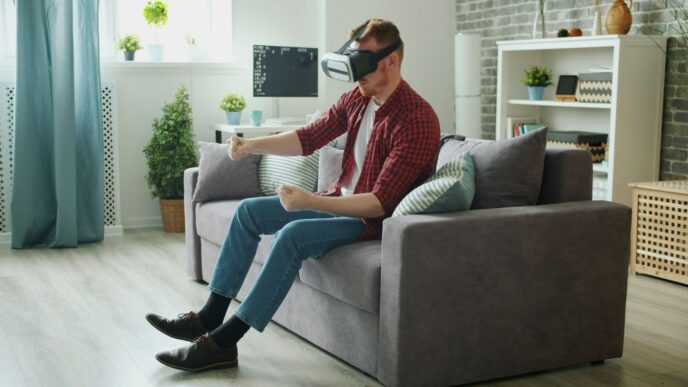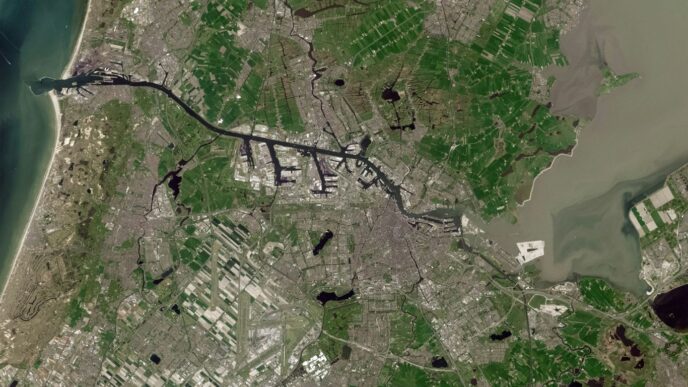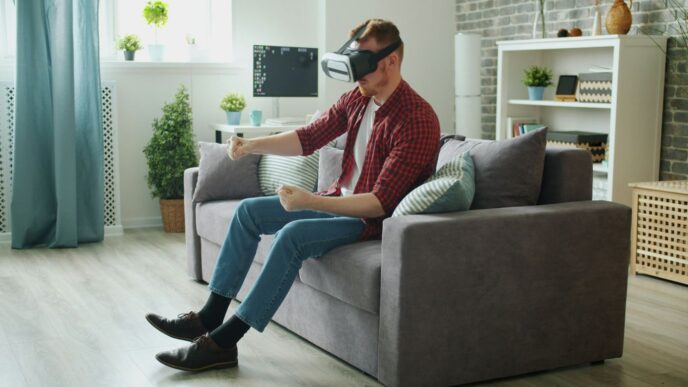Remember when newspapers were just paper? Things are changing fast. We’re seeing a big shift towards the augmented reality newspaper, and it’s pretty cool. Imagine reading about a storm and actually seeing a 3D model of it right on your table. That’s what this new wave of news is all about, mixing the digital world with what you see around you. It’s making news more engaging, especially for younger folks who grew up with tech.
Key Takeaways
- The augmented reality newspaper brings news stories to life with interactive 3D elements, making reporting more engaging.
- AR technology is transforming journalism by making complex data easier to understand and capturing the attention of younger audiences.
- The art world is using AR to digitize masterpieces and create immersive exhibitions, bridging the gap between art and the public.
- Advancements in 3D modeling and 5G are powering the creation of realistic AR content for news and other applications.
- The future of news consumption will likely involve AR as a key differentiator, changing how information is delivered and experienced.
The Augmented Reality Newspaper Experience
Remember when newspapers were just flat pages with words and pictures? Things are changing, and fast. Augmented reality, or AR, is taking the humble newspaper and giving it a serious upgrade. It’s not just about reading the news anymore; it’s about stepping right into it. Imagine holding your phone over a picture of a political rally, and suddenly, you see a 3D model of the crowd moving and hear snippets of speeches. That’s the kind of immersive experience AR brings to the table.
Bringing News Stories to Life with AR
This technology lets us do some pretty cool things with reporting. Instead of just reading about a new building project, you can see a virtual model of it pop up right on your coffee table. You can walk around it, see different angles, and really get a feel for the scale. It’s like having a miniature version of the world appear in your living room. This makes complex stories much easier to grasp. For example, a report on a new bridge could include an AR overlay showing how it’s constructed, piece by piece. It’s a whole new way to visualize information.
Interactive Storytelling for a New Era
AR is really changing how stories are told. Think about a feature on a historical event. With AR, you could point your device at a photo, and suddenly, you’re seeing a reenactment unfold right there. Maybe you can even tap on different characters to hear their personal accounts. It turns passive reading into an active exploration. This kind of interaction keeps people engaged longer and helps them connect with the material on a deeper level. It’s a big shift from just looking at static images. We’re seeing some really creative uses of this, like virtual art exhibitions that let you explore pieces from your own home.
Enhancing Viewer Engagement Through Technology
Ultimately, AR is about making the news more engaging. It’s a way to cut through the noise and grab people’s attention. When you can interact with the content, it sticks with you more. Studies have shown that younger audiences, in particular, respond really well to these kinds of presentations. It’s not just a gimmick; it’s a tool that can make news reporting more effective and memorable. This technology helps bridge the gap between the printed word and the real world, making information more accessible and interesting for everyone.
Augmented Reality’s Impact on Journalism
Augmented reality is really changing how news gets told. It’s not just about showing pictures anymore; it’s about making the stories jump out at you. Think about weather reports. Instead of just a meteorologist pointing at a flat map, imagine them standing next to a 3D model of a hurricane, showing you exactly where it’s heading and how strong it is. This kind of visual storytelling makes complex information much easier to grasp. It’s like having a live, interactive lesson right in your living room.
Transforming Weather Reporting with AR
Meteorologists are finding AR to be a game-changer. It lets them create dynamic visuals that pull viewers in. For instance, a meteorologist could show a city skyline and then have rain or snow appear realistically over it, demonstrating the forecast in a way that’s both informative and engaging. Studies show that younger viewers, especially, respond well to this. One survey found that over half of people aged 25 to 34 prefer weather forecasts that use AR technology. It’s a smart way for stations to keep audiences hooked, especially when competing for attention online. This technology helps make the weather story more compelling.
Making Complex Data Accessible and Engaging
Beyond weather, AR can break down other complicated topics. Imagine a news report on the economy where you can see a 3D graph of stock market trends appear in your room, or a report on a political issue that shows a visual representation of voting data. This makes abstract numbers and concepts feel more real and understandable. It’s a way to present data that doesn’t just inform but also educates in a more memorable way. It’s about making information stick.
Capturing Younger Audiences with Innovative Formats
News outlets are realizing that to connect with younger demographics, they need to speak their language, and that often means embracing new technology. AR offers a fresh, interactive way to consume news that feels more like entertainment or a game than a traditional broadcast. By incorporating AR elements, news organizations can create content that is not only informative but also shareable and exciting, helping them build a loyal audience for the future. It’s a way to stand out in a crowded media landscape.
Art and Augmented Reality: A New Frontier
It’s pretty wild how art is changing, isn’t it? We’re seeing artists use augmented reality in ways that are totally new. Think about seeing a famous sculpture right in your living room, or walking through a gallery that only exists on your phone. It’s like the art world is getting a digital makeover, and it’s making art way more accessible.
Digitizing Masterpieces for AR Exploration
One of the coolest things happening is how museums and galleries are taking their collections and making them available through AR. They’re creating these detailed 3D models of artworks. This means you can look at a painting or sculpture from every angle, zoom in on details you’d never see in person, all from your couch. It’s a big deal for people who can’t travel to see these pieces. For example, the Victoria Miro gallery has a platform that lets you explore their shows digitally, which is a neat way to connect with art. This process involves careful 3D scanning and modeling to get the textures and colors just right, so it feels like you’re really there. It’s a lot of work to capture art in 3D for augmented and virtual reality, but the results are pretty amazing.
AR Exhibitions and Immersive Art Experiences
Beyond just viewing existing pieces, artists are creating entirely new experiences with AR. Imagine walking through a park and seeing virtual sculptures appear around you, or having a historical event reenacted in AR right on your street. Some artists are even using AR to bring abstract concepts to life, like visualizing climate data or creating interactive narratives. These aren’t just static displays; they’re often interactive, letting you play with the art or uncover hidden layers of meaning. It’s a way to make art feel more alive and engaging, especially for younger folks who are used to interactive digital content. It’s a whole new way to experience art, moving beyond the traditional gallery walls.
Bridging the Gap Between Art and Audience
Ultimately, AR is helping to break down barriers. It’s making art less intimidating and more relatable. When you can interact with art in your own space, it feels more personal. This technology also opens up new avenues for artists to get their work seen, especially those who might not have traditional gallery representation. Augmented reality is really changing how we connect with creativity, making it a more democratic and engaging experience for everyone. It’s exciting to see where this goes next, as more artists and institutions explore the possibilities.
The Technology Behind the Augmented Reality Newspaper
So, how do we actually get these news stories to pop out of our screens and into our living rooms? It’s all about the tech, and it’s pretty cool stuff. Think of it like building a digital twin of the real world, but with extra layers of information and interaction. The magic really happens when digital content is overlaid onto our physical surroundings.
3D Modeling for Realistic AR Content
First off, you need to create these 3D models. This isn’t just about making a flat picture look round; it’s about crafting detailed digital objects that look and behave like their real-world counterparts. For a news story about, say, a new car model, designers would build a precise 3D replica. This involves careful attention to textures, lighting, and scale. It’s a bit like digital sculpting, but with a focus on accuracy. The goal is to make these digital objects feel tangible, so when you see a 3D model of a building or a historical artifact appear in your room, it feels believable. This is how places like the Metropolitan Museum of Art are bringing their collections to life.
The Role of 5G in AR Advancements
Now, getting all this detailed 3D data to your device quickly and smoothly is where 5G comes in. Older networks just can’t handle the amount of information needed for high-quality AR experiences. 5G offers much faster speeds and lower latency, meaning less lag and more responsive interactions. Imagine watching a live weather report where the 3D storm system moves in real-time as the meteorologist talks about it. That kind of instant data transfer is what 5G makes possible. It’s a game-changer for anything that needs to be updated and displayed instantly, like live sports stats or breaking news updates. This is similar to how Virgin Galactic is using advanced tech for their space tourism ventures.
User-Friendly AR Tools for Content Creators
It’s not just about the fancy tech on the user’s end; it’s also about making it easier for journalists and content creators to actually build these AR experiences. We’re seeing more and more tools that simplify the process. Instead of needing a team of expert 3D modelers and coders for every story, there are now platforms that allow creators to import 3D assets, add interactive elements, and publish AR content with less technical know-how. Think of it like drag-and-drop website builders, but for augmented reality. This democratization of AR tools means more news outlets can experiment with and adopt this technology, leading to a wider variety of engaging news content. It’s about making the creation process as accessible as the consumption.
Augmented Reality in the Newsroom
Bringing the news to life in a newsroom isn’t just about fancy graphics anymore. It’s about giving journalists new tools to tell stories in ways we haven’t seen before. Think about it: instead of just showing a map of a hurricane’s path, a meteorologist can now stand in front of a holographic storm system, pointing out wind speeds and storm surges right there in the studio. This makes complex weather patterns much easier for viewers to grasp. AR is changing how reporters gather and present information, making news more engaging and understandable.
Empowering Journalists with AR Tools
Journalists are getting new ways to work. Imagine a reporter on location using AR glasses to see real-time data overlays about a building’s structural integrity during a disaster report, or getting instant fact-checks without breaking stride. It’s like having a digital assistant built right into their field of vision. This technology can help them be more accurate and efficient, especially when dealing with fast-moving stories. It’s a big shift from just holding a microphone.
Streamlining AR Scene Creation
Creating these AR experiences used to take a whole team of specialists. Now, there are tools that make it simpler for newsrooms to build their own 3D environments and place virtual objects within them. This means a smaller team can produce more sophisticated AR content. For example, a news producer could drag and drop a 3D model of a historical artifact into a virtual studio space for a documentary segment. It’s about making the technology accessible so more stories can benefit from it. We’re seeing AI play a role here too, helping to generate some of these visual elements, making the process even faster.
Delivering News Beyond Traditional Formats
AR allows news organizations to break free from the flat screen. Instead of just reading about a new bridge design, you can see a 3D model of it appear on your coffee table. This kind of immersive storytelling can really help audiences connect with the news on a deeper level. It’s not just about reporting facts; it’s about creating an experience. This is especially important for reaching younger viewers who are used to interactive digital content. It’s a way to make the news feel more relevant and less like something happening to them, and more like something they can explore. This is a big step in how we consume information, moving towards more interactive digital experiences.
The Future of News Consumption
It feels like just yesterday we were all glued to our phones, scrolling through endless feeds. But things are changing, and fast. Augmented reality (AR) is poised to become a major player in how we get our daily dose of information. It’s not just about looking at news anymore; it’s about stepping into it. Imagine a weather report where you can see a 3D storm system swirling in your living room, or a political story where you can walk around a virtual representation of a proposed building project. This kind of immersive experience is what AR brings to the table.
AR as a Key Differentiator for News Outlets
In a crowded media landscape, news organizations need something to make them stand out. AR offers a unique way to do just that. It’s a chance to move beyond static text and images and create something truly memorable. Think about it: instead of just reading about a new product launch, you could see a virtual model of it right on your desk. This interactivity can really grab people’s attention, especially younger demographics who are already comfortable with digital and interactive content. It’s about making the news more engaging and, frankly, more fun.
The Evolving Role of Visuals in Reporting
We’ve already seen how important visuals are in modern journalism. Photos and videos are standard. AR takes this a step further by adding a layer of depth and interactivity that was previously impossible. It allows for a more nuanced presentation of complex topics. For instance, a story about urban planning could use AR to show how different zoning laws affect a neighborhood, allowing viewers to explore the impact from various angles. This visual storytelling can make abstract concepts much easier to grasp. It’s a big shift from just telling people what’s happening to showing them in a way they can interact with.
AR’s Potential to Revolutionize Information Delivery
Ultimately, AR has the power to completely change how we consume information. It’s not just a gimmick; it’s a new way to understand the world around us. By overlaying digital information onto our physical surroundings, AR can make learning and staying informed a much more active process. We might see news apps that let you point your phone at a landmark and get historical context or current event information instantly. This kind of on-demand, context-aware information delivery is incredibly powerful. It’s like having a personal guide to the world, right in your pocket, making the news feel more relevant and immediate than ever before. It’s a big step forward, and it’s exciting to think about what’s next, maybe something like the iPager but for visual news.
The Future is Now
So, what does all this mean for your morning paper? It means the news isn’t just something you read anymore. It’s something you can see, interact with, and really experience. From seeing a sculpture pop out of the page to watching a weather map come alive right in your living room, augmented reality is changing how we get our information. It’s making news more engaging, especially for younger folks who are already used to this kind of tech. While it’s still early days, it’s pretty clear that AR is going to be a big part of how we consume news in the years to come. Get ready for a more dynamic, interactive newsstand – it’s already here.
Frequently Asked Questions
What exactly is an augmented reality newspaper?
Augmented reality, or AR, is like adding a digital layer to the real world. Imagine looking at your newspaper through your phone or tablet, and suddenly, the pictures start moving, or a 3D model pops out of the page! It makes the news feel more alive and engaging.
How does AR make news stories more interesting?
AR can make news stories much more exciting. For example, a weather report could show a 3D storm cloud right in your living room, or a sports article might let you see a player’s stats appear next to them. It’s a new way to tell stories that grabs your attention.
Can AR help explain difficult news topics?
Yes, AR is great for explaining complicated topics. Think about showing how a new bridge is built with a 3D model you can explore, or visualizing how the economy is doing with interactive charts. It helps make tricky information easier to understand.
Why is AR good for reaching younger readers?
Many experts believe AR is a fantastic way to get younger people interested in reading the news. Because it’s interactive and uses cool visuals, it feels more like a game or an app they’re already familiar with.
How is AR changing the way we experience art?
AR can bring art to life in amazing ways. You could see a famous painting appear in your room, or explore a sculpture from every angle without leaving your house. It’s like having a virtual museum visit!
What kind of technology makes AR newspapers possible?
The technology behind AR newspapers involves creating 3D models of objects or scenes, and then using special software to place them in the real world through your device’s camera. Faster internet speeds, like 5G, also help make these experiences smooth and quick.














